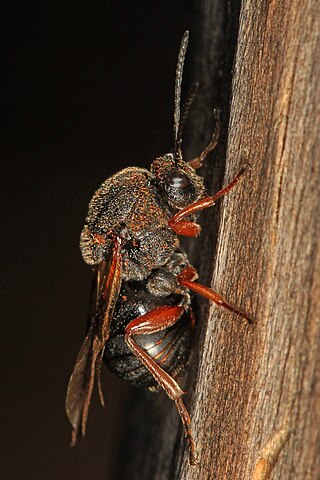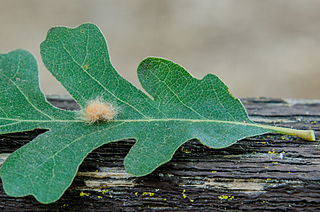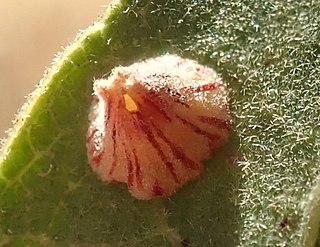
Gall wasps, also traditionally calledgallflies, are hymenopterans of the family Cynipidae in the wasp superfamily Cynipoidea. Their common name comes from the galls they induce on plants for larval development. About 1,300 species of this generally very small creature are known worldwide, with about 360 species of 36 different genera in Europe and some 800 species in North America.

Andricus foecundatrix is a parthenogenetic gall wasp which lays a single egg within a leaf bud, using its ovipositor, to produce a gall known as an oak artichoke gall, oak hop gall, larch-cone gall or hop strobile The gall develops as a chemically induced distortion of leaf axillary or terminal buds on pedunculate oak or sessile oak trees. The larva lives inside a smaller hard casing inside the artichoke and this is released in autumn. The asexual wasp emerges in spring and lays her eggs in the oak catkins. These develop into small oval galls which produce the sexual generation of wasps. A yew artichoke gall caused by the fly Taxomyia taxi also exists, but is unrelated to the oak-borne species. Previous names or synonyms for the species A. fecundator are A. fecundatrix, A. pilosus, A. foecundatrix, A. gemmarum, A. gemmae, A. gemmaequercus, A. gemmaecinaraeformis and A. quercusgemmae.

Andricus is a genus of oak gall wasps in the family Cynipidae.

Cynipini is a tribe of gall wasps. These insects induce galls in plants of the beech and oak family, Fagaceae. They are known commonly as the oak gall wasps. It is the largest cynipid tribe, with about 936 to 1000 recognized species, most of which are associated with oaks. The tribe is mainly native to the Holarctic.

Andricus quercuscalifornicus, or the California gall wasp, is a small wasp species that induces oak apple galls on white oaks, primarily the valley oak but also other species such as Quercus berberidifolia. The California gall wasp is considered an ecosystem engineer, capable of manipulating the growth of galls for their own development. It is found from Washington, Oregon, and California to northern regions of Mexico. Often multiple wasps in different life stages occupy the same gall. The induced galls help establish complex insect communities, promoting the diversification in niche differentiation. Furthermore, the adaptive value of these galls could be attributed their ecological benefits such as nutrition, provision of microenvironment, and enemy avoidance.

Andricus aries is a species of gall-forming wasps, in the genus Andricus. The species was named by the French entomologist Joseph-Étienne Giraud, in 1859. It is commonly found in eastern Europe and during the 21st century has spread to western Europe.
Andricus quercusfoliatus, the leafy oak gall wasp, is a species of gall wasp in the family Cynipidae.

Feron kingi, the red cone gall wasp, is a species of gall wasp in the family Cynipidae.
Striatoandricus is a genus of Neotropical gall wasps (Cynipidae). There are six described species, four of which were formerly included in Andricus. All species induce galls on oaks in which their larvae live and feed.
Synergus japonicus is a species of gall wasp in the family Cynipidae. Whereas most gall wasps create the galls in which they live, Synergus japonicus is an inquiline species, living in the gall created by another species of wasp. It is native to Japan, China and Russia.

Druon fullawayi, also known as the yellow wig gall wasp, is a species of gall wasp in the family Cynipidae. It was previously placed in the genus Andricus. William Beutenmüller described the female adult wasps as 1.5-2.25 mm long, black with brown mouth parts and brown legs. The galls of D. fullawayi are tan or yellow, woolly, and measure 5-8 mm in diameter. Each gall holds a single chamber for larvae. They are found in California on oak trees, especially Quercus lobata.

Feron crystallinum, also known as the crystalline gall wasp, is a species of gall-forming wasp in the genus Feron. Its galls are pink and covered in hairs that are white, red, or brown. These galls are often massed together in clumps that can cover the underside of leaves. Individual galls are 12–14 mm high, 7 mm across, and have a single chamber for larvae. The unisexual female generation emerges in late winter, and the bisexual generation of males and females emerges in March. They are found in all species of oaks in California.

Feron parmula, also known as the disc gall wasp, is a species of oak gall wasp in the genus Feron. It induces galls in a wide selection of oak species, especially white oaks, and including hybrids. The galls are disc-shaped, up to 3 mm in diameter, and pale with red streaking. Adult females emerge in April. The galls induced by F. parmula superficially resemble the galls of Feron gigas,Andricus viscidus, and newly identified species called the "plate gall wasp" and the "orange-cap gall wasp" by Ronald Russo. Galls induced by this wasp have been documented in Oregon and California on the Pacific coast of North America.

Feron gigas, also known as the saucer gall wasp, is a species of gall-forming wasp in the genus Feron. It induces galls on the leaves of scrub oaks, blue oaks, and Engelmann oaks. The galls produced by its all-female generation, which emerges in winter, are 3-4 mm wide, circular with raised edges. They are red, pink, brown, or purple. The larval chamber exists as a raised bump in the gall's center. The bisexual generation produces galls that are brown and cone-shaped.

Feron pattersonae, also known as the plate gall wasp, is a species of oak gall wasp in the genus Feron. Their hosts are among the white oaks grouping of oaks, with blue oak being common.

Feron atrimentum, also known as the striped volcano gall wasp, is a species of gall-forming wasp in the genus Feron. It induces galls on blue oak leaves. Like other oak gall wasps, it has two generations: a bisexual generation, and a parthenogenic female generation. The bisexual generation produces round, 3–4 millimetres (0.12–0.16 in) galls in spring that start as green or pink, and then turn brown. The unisexual generation produces conical, 4–4 millimetres (0.16–0.16 in) galls in summer that are pale with red stripes.

Callirhytis perfoveata, formerly Andricus perfoveata, the leaf ball gall wasp, is a species of hymenopteran that produces leaf galls on oak trees in California in North America. The wasp oviposits on coast live oak, interior live oak, and occasionally on California black oak, and induces what appears to be a roughly spherical gall embedded within the leaf. The gall is initially bright green and turns brown as it ages.

Trichoteras tubifaciens, formerly Andricus tubifaciens, also known as the crystalline tube gall wasp, is an uncommon species of cynipid wasp that produces galls on oak trees in Califoeni and Oregon in North America. This wasp oviposits on the midrib of the underside of the leaves of Oregon oaks. Up to 35 galls have been observed on a single leaf. Cream, yellow, red, and multicolor variants have been documented.

Andricus stellaris, the sunburst gall wasp, is a fairly common species of cynipid wasp that produces galls on blue oaks and Oregon oaks on the Pacific coast of North America. The wasp oviposits on the underside of leaves, between the lateral veins; the larval chamber is the brightly colored spot at the center of the gall. The chamber is surrounded by a crystalline structure.

Feron is a genus of oak gall wasps in the Nearctic. It was established by Alfred Kinsey in 1937, then re-established in 2023.

















